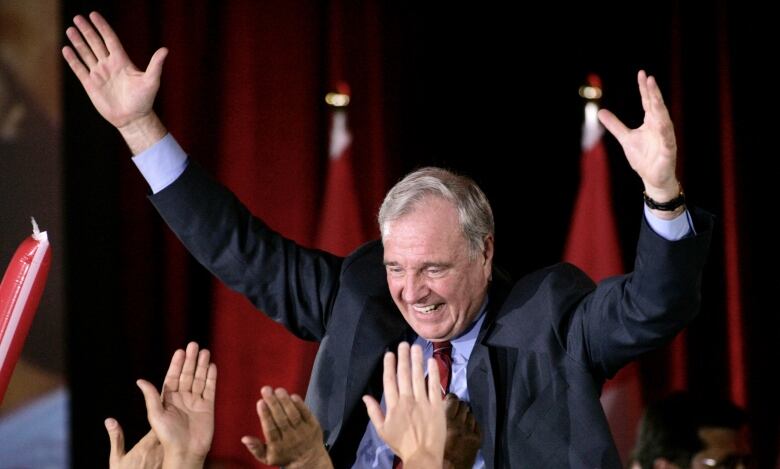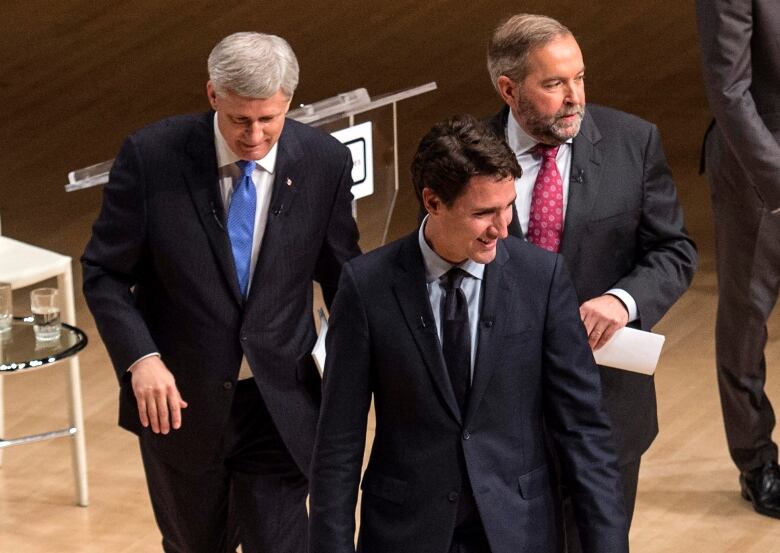Close elections like this one are rare and hard to predict
Conservatives, Liberals neck-and-neck in polls with 2 weeks to go, and that's unusual

We're nearly four weeks into this campaign and the polls haven't budged meaning the Conservatives and Liberals remain neck-and-neck in national voting intentions just two weeks out from the Oct. 21 vote.
It might seem unusual that this election has remained deadlocked for so long andit is. Only a handful of previous federal elections saw the leading parties polling this close to each other for this long.
And each of those previous elections offers some guidance as to what Canadians can expect this time.
Since modern political polling in Canada began around the Second World War, there have been only three examples of prolonged toss-ups: 1979, 2004 and 2015. While the last one resulted in Justin Trudeau's Liberals coming to power, the other two ended in short-lived minority governments.
Those three cases show what could happen between now and election day: an unpredictable outcome, a surprise result that defies the pollsor a volatile final two weeks in which the electoral landscape shifts.
1979: Clark wins on seats, Trudeau on votes
After 11 years in office and facing skyrocketing inflation and high unemployment, Pierre Trudeau's Liberals were facing headwinds as they headedinto the 1979 federal election. The Progressive Conservatives surged in the polls after choosing Joe Clark as their leader in 1976, but by the end of 1978 the PCs and Liberals were neck-and-neck in the polls.
That close race held straight through to the May election. With roughly two weeks to go before the vote, Gallup put the Liberals and PCs within one point of each other. The final polls of the campaign put the two parties in a literal tie the final Gallup survey showed 37.5 per cent for both parties.

The polls were not far off the result on election night. The Liberals captured 40 per cent of the vote,and the PCs came in with 36 per cent. But the Liberal vote was inefficient Trudeau's party captured 62 per cent of the vote in Quebec and 67 of the province's 75 seats, but was beaten in Ontario and elected only three MPs in Western Canada.
Despite losing the popular vote, Clark's PCs won more seats: 136 to the Liberals' 114. His wobbly minority government survived less than a year. Trudeau's Liberals returned with a majority in 1980.
That is one scenario that could play out in 2019. The polls might continue to show a neck-and-neck race through to election day, and the result could be counterintuitive. The Poll Tracker consistently has shown the Conservatives leading (if narrowly) in national voting intentions but trailing the Liberals in the seat projection.
Alberta and Saskatchewan could play the role for Andrew Scheer's Conservatives that Quebec played for Pierre Trudeau's Liberals in 1979 giving him lots of extra votes that pump up his national numbers but do not help him win extra seats in the rest of the country.
2004: Liberals lose their majority, defy the polls
Jean Chrtien was no longer prime minister, but the Liberals had been in power for over a decade when Paul Martin sent the country to the polls in 2004. Once seen as unstoppable, Martin's Liberals had been hobbled by the sponsorship scandal and were no longer facing a divided opposition after the PCs and Canadian Alliance merged to form the Conservative Party at the end of 2003.
The polls suggested it was going to be close when Canadians voted in June. While a few polls suggested the Liberals had the edge over Stephen Harper's Conservatives, on average the gap between the two parties in the final weeks of the campaign was less than a percentage point.

Ipsos-Reid, polling for CTV and the Globe and Mail, gave the Liberals just a one-point advantage over the Conservatives, but estimated that Harper had the best chance of winning more seats. The Canadian Press called it "too close to call". Three days before the election, the Globe and Mail ran a banner headline: "DEAD HEAT."
In the end, it wasn't. The Liberals beat the Conservatives by seven percentage points nationwide and won 135 seats to the Conservatives' 99. That limited Martin to a minority government Martin would be defeated 18 months later but it was still a clear Liberal victory.
That could happen again in 2019. By Oct. 21, the polls could still be showing a close race. Polling error, last-minute voter decisions or significant turnout effects could produce a result very different from what the polls are showing. This is why the Poll Tracker shows a wide range of potential outcomes when it's this close, even small differences between the polls and the results can have big consequences.
2015: Neck and neck (and neck), until it wasn't
The last campaign is remembered for its volatility. The New Democrats started as the front-runners, only to be overtaken by the Liberals, who were swept to a surprising majority government. What few people remember nowis that the biggest shifts happened in the last weeks of the campaign.
Throughout September, the election was a three-way toss-up something unique in Canadian federal election history. At the beginning of that month, only three percentage points separated first place (Tom Mulcair's NDP) from third place (Justin Trudeau's Liberals). By the end of the month, the gap was just five points, though the NDP had fallen to third and the Conservatives had moved into first.

It was still only marginal movement. It took two months for the Liberals to gain four points nationwide. But that movement accelerated in the last few weeks, with the Liberals averaging an increase of about three to four pointsin each of the last two weeks of the campaign. Polls done over the final days suggested the Liberals were approaching majority territory, but only a few surveys suggested they had crossed that threshold.
This is the final scenario that could play out over the next two weeks and there is significant potential for it. Unlike in 2015, when the final debate was held 17 daysbefore the election, there will be two debates held in the coming week before the long Thanksgiving weekend. That could shift the numbers in a big way enough to produce a Liberal majority, a Conservative majority or anything in between.
So the 2019campaign is unusual but not unique. History gives us no clear picture of what to expect. We'llhave to wait another two weeks for history to be made again.













_(720p).jpg)


 OFFICIAL HD MUSIC VIDEO.jpg)
.jpg)



























































































